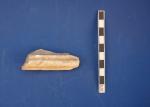Interpretation
-
- Fill of grave 3103. It is possible that this was a very important grave finished with spicatum bricks (3143), though this may be from a second phase of using the tomb (since a brick of this sort was found at the bottom of fill 3104). Given the presence of the disarticulated skeleton in the fill (at the SE corner of the cut under the right lower leg of *3102) it does seem likely that the grave was used more than once. See interpretation for 3153.
-
- Megan McNamee
- 27-7-2007
Stratigraphic Relationships
Site Photo
- No records attached.
Description
- Composition, color, compaction - the fill for *3102 is darker and less yellow than 3096 and it contais many more and larger inclusions.
- trowel
- N-S: 0.59 m; E-W: 1.62 m
- sandy earth containing pebbles and other small to medium sized inclusions
- light gray with small white pieces of plaster
- loose when first excavated in 2006, much harder after being exposed
- good
- artificial
- sand, clay, pebbles
- carbon, human bone
- fragments of plaster, bronze, traces of mortar, painted plaster, fragments of worked marble, ceramic
- A sandy fill of cut 3103. A pile of disarticulated body is visible in its west area. Possibly destroyed for the making of cut 3103.
- 3104 was partially excavated in 2006, but, since *3102 was not excavated until 2007, half of the fill remained in situ and exposed.
- high
Ceramic Inventory
| Total fragments | |
|---|---|
| 2 | |
| 2 | |
| 1 |

